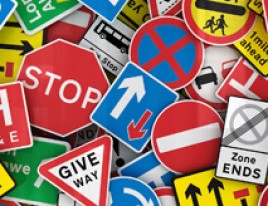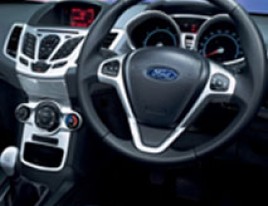
Driving Tutorials | Controlled (Emergency) Stop
Stopping In an Emergency
In normal conditions a good driver should never have to brake hard. However emergencies happen. For instance if a child runs into the road in front of you, you have to know how to stop your car quickly and under control. Stopping in an Emergency increases the risk of skidding.
A quick reaction is crucial in an emergency as the sooner you start braking the sooner you will stop. An emergency stop is the only manoeuvre where you don't need to check your mirrors as you need to concentrate on what's in front of you rather than behind. That split second of checking your mirrors could be somebodies life.
Even when stopping in an emergency follow the rule of Progressive Braking-pressing the brake pedal harder as the vehicle slows down
How to do an Emergency Stop
- Keep both hands on the steering wheel as you need to keep control as much as possible. You may need to swerve to avoid hitting someone.
- Avoid stamping on the brakes as you may lock the wheels. This could cause the car to skid sideways and cause serious loss of control. However if your vehicle is fitted with ABS (Anti-lock Braking System) this system activates automatically when braking harshly.
- Press the clutch pedal down just before you stop, this will help your braking and stability. Try not to put the clutch down too soon as again this can cause the wheels to lock and the car to skid.
- Once you have come to a complete stop apply the parking brake, check you interior mirror and select neutral if safe behind. You may see a car in the mirror and need to move again to stay out of danger.
- Before moving away select 1st gear do all round observations including blind spots ( Remember you have just come to a complete stop in the middle off the road so all round observations is crucial) and then move away when safe.
How to avoid doing an Emergency Stop
- Try to avoid the emergency arising by looking well ahead and being aware of what's around you.
- Drive at such a speed that you can stop safely in the distance you can see to be clear. If it's not clear slow down.
- Prepare for the unexpected.
Anti-Lock braking systems (ABS)
If your vehicle is fitted with ABS brakes the system operates automatically under conditions of harsh braking.
ABS employs wheel speed sensors to anticipate when a wheel is about to lock under extreme braking. Just before the wheels begin to lock, the system releases the brakes momentarily before automatically reapplying them sending a pulsing sensation through the brake pedal. This can be quite frightening the first time it occurs and you may be tempted to respond by relaxing the pressure on the brake pedal. However it is important that maximum pressure is maintained. ABS helps you to Brake as well as Steer, something you would not be able to do if your wheels were locked. Reducing the pressure on the brake pedal or pumping the pedal reduces the effectiveness of the system.The pressure on the brake pedal must be maintained until the hazard is safely avoided.
ABS will enhance your skills NOT replace them although knowing ABS you will stop safely should not encourage you to drive less carefully.
Skidding
The three main points of skidding are
- The Driver
- The condition of the tyres on your vehicle
- The road surface
Skids don'y just happen they are caused by the driver asking too much of the vehicle for the amount of grip the tyres have on the road.
There's an increased risk of skidding as you
- slow down
- speed up
- turn a corner or round a bend
- drive uphill or downhill
You must steer the vehicle into the skid and ease off the accelerator as this will bring the car more under control.






